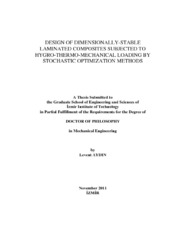Please use this identifier to cite or link to this item:
https://hdl.handle.net/11147/3170Full metadata record
| DC Field | Value | Language |
|---|---|---|
| dc.contributor.advisor | Artem, Hatice Seçil | - |
| dc.contributor.author | Aydın, Levent | - |
| dc.date.accessioned | 2014-07-22T13:51:01Z | - |
| dc.date.available | 2014-07-22T13:51:01Z | - |
| dc.date.issued | 2011 | - |
| dc.identifier.uri | http://hdl.handle.net/11147/3170 | - |
| dc.identifier.uri | http://library.iyte.edu.tr/tezler/doktora/makinamuh/T000984.pdf | - |
| dc.description | Thesis (Doctoral)--Izmir Institute of Technology, Mechanical Engineering, Izmir, 2011 | en_US |
| dc.description | Includes bibliographical references (leaves: 147-150) | en_US |
| dc.description | Text in English; Abstract: Turkish and English | en_US |
| dc.description | xvii, 153 leaves | en_US |
| dc.description.abstract | The materials used in aerospace structures such as antenna, satellites and missiles should have such features as low density, high stiffness, low coefficients of thermal and moisture expansions simultaneously. Fiber reinforced polymer composite materials can satisfy these requirements with an appropriate stacking sequence using optimization methods and hence dimensionally stable composites are obtained. In this thesis, two different materials carbon/epoxy and E-glass/epoxy composites are considered. Both materials have been used for optimization, stress and failure analysis. However, only for E-glass/epoxy, experimental studies have been performed including determination of stiffness, strength characteristics, Poisson's ratio, fiber volume fraction, glass transition temperature (Tg) and coefficient of thermal expansion (CTE). The objective of optimization part is to design the stacking sequence of the carbon/epoxy and E-glass/epoxy laminated composites having low CTE and high elastic moduli. In design process, multi-objective genetic algorithm optimization of the carbon/epoxy composite plates are verified by single-objective optimization approach by using the Genetic Algorithm (GA), Generalized Pattern Search (GPS) and Simulated Annealing (SA) algorithms. MATLAB Optimization Toolbox is used to obtain Pareto-optimal designs and global optimum points for different model problems. Stress and strain distributions are presented through the thickness of the laminates subjected to mechanical, thermal, and hygral loadings. Stress analysis results showed that effect of mechanical loads dominate to hygral and thermal loads. All the stochastic search methods carried out in the present thesis have produced almost the same results with different stacking sequences. | en_US |
| dc.language.iso | en | en_US |
| dc.publisher | Izmir Institute of Technology | en_US |
| dc.rights | info:eu-repo/semantics/openAccess | en_US |
| dc.subject.lcsh | Mathematical optimization | en |
| dc.subject.lcsh | Composite materials | en |
| dc.title | Design of Dimensionally-Stable Laminated Somposites Subjected To Hygro-Thermo Loading by Stochastic Optimization Methods | en_US |
| dc.type | Doctoral Thesis | en_US |
| dc.department | Thesis (Doctoral)--İzmir Institute of Technology, Mechanical Engineering | en_US |
| dc.relation.publicationcategory | Tez | en_US |
| dc.identifier.wosquality | N/A | - |
| dc.identifier.scopusquality | N/A | - |
| item.openairecristype | http://purl.org/coar/resource_type/c_18cf | - |
| item.languageiso639-1 | en | - |
| item.openairetype | Doctoral Thesis | - |
| item.grantfulltext | open | - |
| item.fulltext | With Fulltext | - |
| item.cerifentitytype | Publications | - |
| Appears in Collections: | Phd Degree / Doktora | |
Files in This Item:
| File | Description | Size | Format | |
|---|---|---|---|---|
| T000984.pdf | DoctoralThesis | 4.2 MB | Adobe PDF |  View/Open |
CORE Recommender
Page view(s)
258
checked on Mar 31, 2025
Download(s)
250
checked on Mar 31, 2025
Google ScholarTM
Check
Items in GCRIS Repository are protected by copyright, with all rights reserved, unless otherwise indicated.